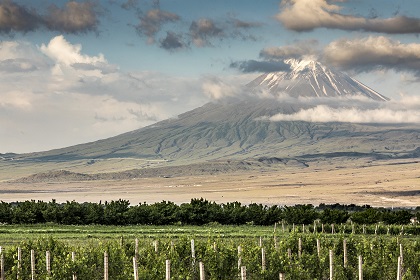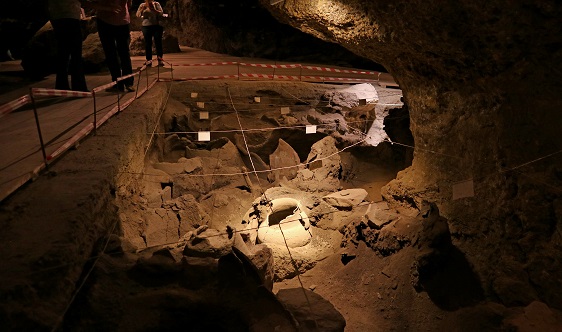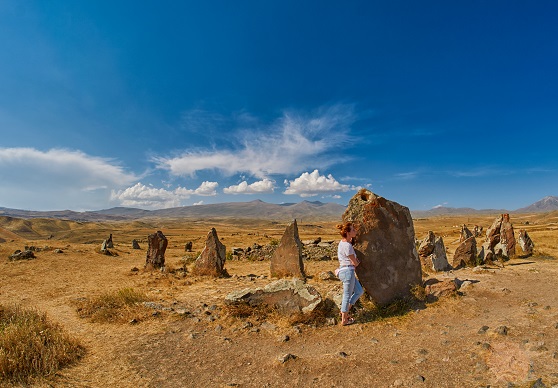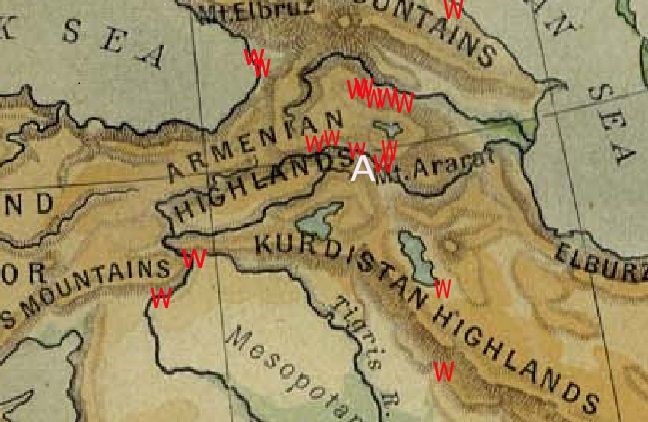Some believe that the Biblical account of Noah is a myth; some say it is an allegory; and some, like the present writer, say it is a true historical account. So far, we have not found Noah’s colossal Ark; maybe it was recycled by our ancient ancestors, covered by an ice cap, or buried by the Mount Ararat volcano; nonetheless, the search for Noah’s Ark continues. Meanwhile, we, at Genesis and Genetics, are looking for evidence of Noah in other places, one of which is searching for Noah’s vineyard. So, let’s combine our knowledge of the Bible with modern science and search for Noah’s vineyard.
The Bible says that after leaving the Ark:
Genesis 9:20 Noah began to be an husbandman, and he planted a vineyard … (KJV)
Noah planted a vineyard; but, by now, surely all signs of Noah’s vineyard have disappeared. Right? It appears that is not the case; ancient grape seeds (pips) have been found near Mount Ararat. These grape pips have been carbon dated and genetically sequenced. As a result, their DNA has been traced to modern grapes. These results are illuminating, but before we get into the migration of grapes, let’s get a bit more background from the Bible concerning Noah and his Ark:
Genesis 8:4 And the ark rested in the seventh month, on the seventeenth day of the month, upon the mountains of Ararat (KJV).
The Hebrew word “Ararat” is the word for “Armenia.” When Noah’s Ark settled in the mountains of Armenia, the Armenian borders had yet to be defined; however, the Bible is a timeless book and we can assume ancient Armenia included present-day Armenia. Also, going back in history to just after the time of Moses, we find that ancient Armenia included modern-day Armenia, Eastern Turkey, Azerbaijan, and Southern Georgia. Therefore, logically, Noah’s vineyard should be in one of these countries. The Bible states that the Ark settled in the mountains of Armenia; so, it could have landed on Mount Ararat or any of the Armenian mountains. Christian tradition gives Mount Ararat the honor of being the place of disembarkation from the Ark, and it is, for sure, a possibility.
We find that the modern countries representing ancient Armenia are, indeed, rich in wine history. Here are some facts:
- Georgia is touted by many as being the birthplace of wine. It claims to have been making wine for 8000 years. In the days of the Soviet Union, Georgia was known as the Soviet Union’s wine cellar.
- Azerbaijan also touts its ancient winemaking. Azerbaijan has much diversity in landscape, some of which are perfect for growing grapes.
- Present-day Armenia has a long history of wine culture. Many modern-day Armenians consider wine as the national drink. In Armenia, there are legends that Noah planted his vineyard in the Ararat Valley (Figure 1).
Figure 1 Mount Ararat with vineyards in the foreground
Armenia boasts of having the world’s oldest winemaking facility located in Areni Cave (Figure 2).
Figure 2 Excavations in Areni cave
In addition, Armenia is rich in ancient history. For example, Carahunge, Armenia is a Stonehenge-like site. Many of the stones have holes drilled in them, and they are called speaking stones in that they make noise as the wind flows through them. The Carahunge formation of stones predates the British Stonehenge by approximately 4000 years, dating it to approximately the same age as the most ancient Armenian vineyards.
Figure 3 Carahunge, the Armenian Stonehenge predating the British Stonehenge by nearly 4000 years.
DNA sequencing shows that most Domestic wines owe their origins to wild grapes in the Near East.
Since the discovery of DNA, many mysteries are being solved in various fields  including horticulture. Worldwide, one of the most valuable horticultural crops is grapes; therefore, scientists give much attention to viticulture. DNA markers (SNPS) are used to connect domestic grapes to wild species and trace their migration from country to country. According to an article in PNAS (proceeding from the National Academy of Science), grape domestication began 6,000 to 8,000 years ago with the wild grape Vitis vinifera sp. Sylvestris. This grape is common in the Northern hemisphere, but they have traced domestic grapes to the DNA most closely aligned with those wild grapes from the Near East, specifically Armenia, Georgia, and Azerbaijan (reference 1). Therefore, the origin of domestic grapes is coincident with Noah’s wine country in ancient Armenia. This, of course, does not prove the Biblical account of Noah, but it shows the scientific evidence is consistent with the Biblical narrative.
including horticulture. Worldwide, one of the most valuable horticultural crops is grapes; therefore, scientists give much attention to viticulture. DNA markers (SNPS) are used to connect domestic grapes to wild species and trace their migration from country to country. According to an article in PNAS (proceeding from the National Academy of Science), grape domestication began 6,000 to 8,000 years ago with the wild grape Vitis vinifera sp. Sylvestris. This grape is common in the Northern hemisphere, but they have traced domestic grapes to the DNA most closely aligned with those wild grapes from the Near East, specifically Armenia, Georgia, and Azerbaijan (reference 1). Therefore, the origin of domestic grapes is coincident with Noah’s wine country in ancient Armenia. This, of course, does not prove the Biblical account of Noah, but it shows the scientific evidence is consistent with the Biblical narrative.
Carbon Dates
We at Genesis and Genetics consider carbon dating good science in principle; however, we have concluded that the calibration curves, based on the uniformitarian model are not correct, and carbon 14 values must be corrected for the Biblical flood effects (Reference 2, To access our carbon 14 date calculator click here). The oldest evidence of winemaking dates to 5900 B.C. Correcting 5900 B.C. for flood effects gives us 2141 B.C. Since the flood receded approximately 2348 B.C., the oldest grape pips found so far lived 200 years after disembarkation from the Ark. Therefore, the oldest vineyard found thus far is probably not Noah’s original vineyard, but they are vineyards planted by Noah’s near kin. If some ancient grapes are carbon dated closer to the flood date of 2348 B.C., it may very well be the vineyard planted by Noah.
Figure 4 shows some of the ancient Armenian vineyards found so far. They probably are those of Noah’s offspring and show the earliest stages of human migration. The present findings are good corroboration of the Biblical narrative and show that (1) Noah’s Ark settled in what is now known to be wine country, (2) there is evidence of ancient winemaking where Noah landed, and (3) that ancient Armenia is the origin of modern domestic grapes.
Figure 4 Some of the Ancient Armenia vineyards found so far (the red W’s denote ancient vineyards and the white A shows the location of Mount Ararat
Summary
The Biblical narrative and archaeological evidence meet in ancient Armenia. Now it is clear that Noah and his offspring planted vineyards in some of the best wine-producing country in the world. Also, Noah’s wine country has been shown to be the origin of modern domestic grapes. Our findings are not proof of Noah’s account but show clearly that the Bible is once again consistent with scientific evidence. So, next time you enjoy a glass of wine, grape juice of a handful of raisins, consider giving Noah a little credit for his husbandry skills and give him a bravo for saving humanity from annihilation.
Coming Soon
Soon we will release a blog concerning the migration out of Noah’s vineyard. We have found that only a portion of Noah’s family “came from the East” and settled in the Land of Shinar (Mesopotamia). We will also identify the historical Nimrod.
References:
- https://www.pnas.org/content/108/9/3530?ijkey=487feaf2bb16b6c3b0eafa120da366ea9d45a464&keytype2=tf_ipsecsha
- https://www.genesisandgenetics.org/2019/07/27/flood-effects-on-radio- carbon-dating/





A very researched, time invested documents. I appreciate your eagerness to learn Bible and willingness to teach others what you learned.But I can surely and confidently state the words of Lord Jesus Christ Word, that you are blind and leading others to more spiritual blindness. If you are earnest to learn truth and want to lead others to truth, (I am an individual in search of truth, not a spokesperson of any organisation) a Swedenborg Project is a Christian organization dedicated to spreading the ideas of a new Christianity, based on the theological and philosophical works of Emanuel Swedenborg. The Project carries out efforts to translate and publish works that relate to New Christian or Swedenborgian thought, and to promote education.
God bless you.
You should never accuse some other Christian of being blind. You may have the log in your eye. Jesus is the only one who has the authority to decide who is blind. I am not calling you blind but would like to point out one problem I have with those in the Swedenborg Project. It appears that you believe that only a few are appointed to decipher the Holy Scriptures. I think this to be dangerous. The Holy Spirit has been appointed to teach us the scriptures and He, alone, can do it properly. We do need preachers and Sunday school teachers to help new converts to get started, but we should all direct believers to the scriptures and guidance of the Holy Spirit.
I do not apologize for writing about Noah’s wine country. People are interested in current scientific findings that support the Bible. If you have some specific criticism of the article please let me know. If it is in error, we will gladly change it.
Admin
Thanks so much for the painstaking effort to publish this writeup. May God continue to give you more inspiration and wisdom in the name of Jesus.